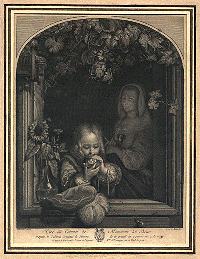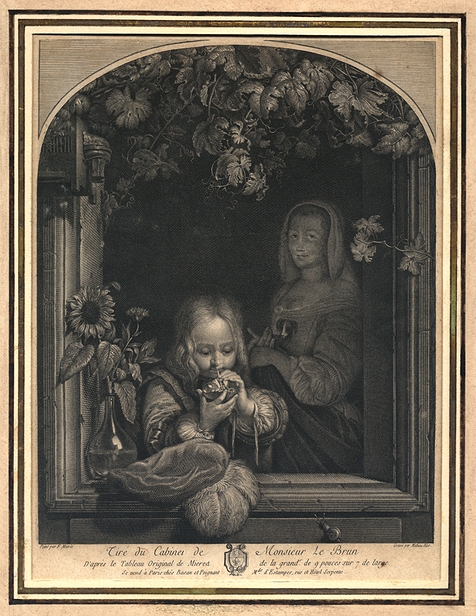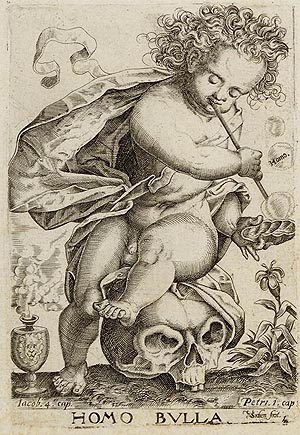 At first sight, this lovely, rather small (18 x 23.5 cm) engraving just depicts a Genre scene of a boy blowing soap bubbles, with his mother standing smiling behind him. Let us explore why there may be something else luring behind than just a scene from an untroubled childhood.
At first sight, this lovely, rather small (18 x 23.5 cm) engraving just depicts a Genre scene of a boy blowing soap bubbles, with his mother standing smiling behind him. Let us explore why there may be something else luring behind than just a scene from an untroubled childhood.
The engraving is a mirrored copy of the painting A Boy blowing Bubbles, a subject which was executed several times by Dutch fijnschilder (”fine painter”) Franz van Mieris (1635-1681). Today, the painting can be admired in the Mauritshuis in The Hague [1].

Frans van Mieris, Boy blowing bubbles, 1663, oil on panel, Royal Picture Gallery Mauritshuis, The Hague.
At the end of the 18th century, the painting was part of the Picture Cabinet of the French Jean-Baptiste Pierre le Brun (1748-1813) in Paris. It was during this time when the French Mathieu Blot (1753-1818) produced his print, which was then sold by the Parisian print dealer Poignant (”Se vend à Paris chés Poignant Mds. D’Estampes, rue et Hôtel Serpente). This was not the first reproduction of this painting: between 1676 and 1678 Dutch engraver Cornelis H. van Meurs had already produced one [2].
The engraving presented here reproduces in an itself virtuoso style the illusionistic picture space: we can discern the weathered state of the window frame and the surrounding wall. A snail is crawling towards the boy, who is self-forgettingly blowing his soap bubbles, while his mother is knowingly smiling towards the observer.
It is this weathered state of the window frame which provides us with a first hint towards the motto of this post. Time has left its traces in the decaying stone and wood objects. The snail seems to have started its long way from outside the picture space (in the original painting, it is crawling over the carved Roman numerals MDCLXIII = 1663). The sunflower was chosen because of its daily movement. And last but not least, the fragile soap bubbles exist only for a blink of an eye.

Mathieu Blot after Frans van Mieris, Boy blowing bubbles, etching and engraving, between 1778 and 1780, private collection.
In this sense, soap bubbles are associated with the transience of life. In the sixteenth century, the Dutch philosopher Erasmus reintroduced the Latin expression “Homo bulla” (”man is a bubble”) in his “Adagia”, a collection of sayings published in 1572. A vanitas etching by the Dutch Karel van Sichem (d. 1608), published 150 years earlier, shows a young boy sitting on a skull and blowing bubbles. “Homo” is written over one of them: a skull as the symbol of death and bubbles representing the transience of man’s life on Earth.

Karel van Sichem: Homo Bulla, around 1617 [4].
The lovingly smiling mother pointing knowlingly at her son may illustrate a further transient element: Even love is as fragile as a bubble and has to be approached with caution (the sunflower was also known as the “trumpet of love”) [5].
Did you notice the blueish color of the leaves in the painting, especially the sunflower leaves? The original green color was made of yellow and blue pigment. During the centuries, the yellow pigment has broken down, leaving only the blue. Even the painting itself is only a bubble in time…
______
[1] Otto Naumann, Frans van Mieris The Elder (1635-1681), Monographs on Dutch & Flemish Paintings, Volume II: Catalogue & plates, Davaco: 1981, p. 70-76).
[2] Jean Siméon Chardin 1699-1779: Werk, Herkunft, Wirkung, 1999.
[5] Naumann, pp. 75-76.

Do you have info regarding La Bonne Mere, by Jean-Honore Fragonard & Nicolas DeLaunay? I am having trouble finding info regarding print.
Thank you kindly,
P Filyaw
See this post for some info.